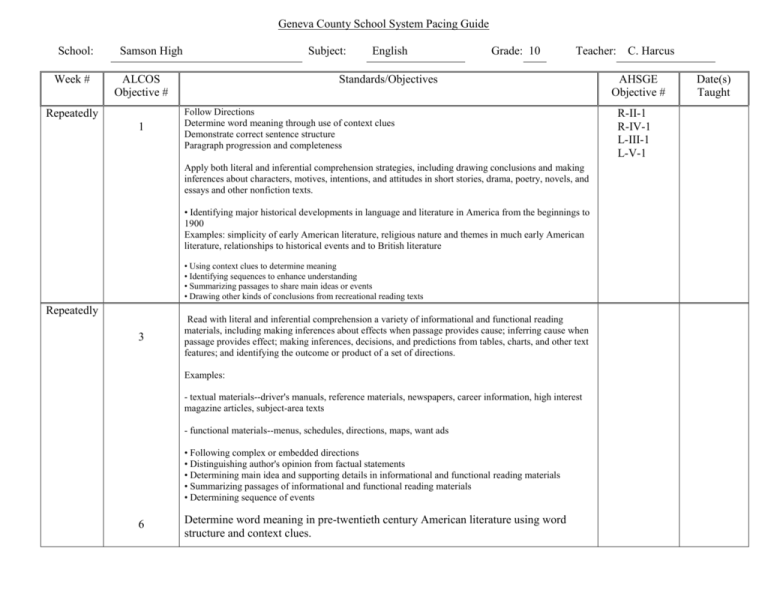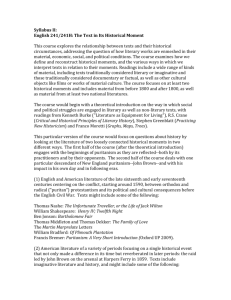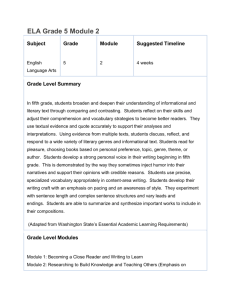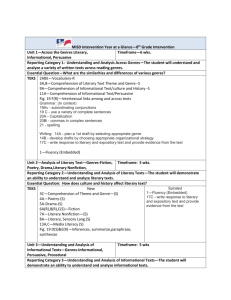Geneva County School System Pacing Guide School: Samson High
advertisement

Geneva County School System Pacing Guide School: Week # Samson High Subject: ALCOS Objective # Repeatedly 1 English Grade: 10 Teacher: Standards/Objectives Follow Directions Determine word meaning through use of context clues Demonstrate correct sentence structure Paragraph progression and completeness Apply both literal and inferential comprehension strategies, including drawing conclusions and making inferences about characters, motives, intentions, and attitudes in short stories, drama, poetry, novels, and essays and other nonfiction texts. • Identifying major historical developments in language and literature in America from the beginnings to 1900 Examples: simplicity of early American literature, religious nature and themes in much early American literature, relationships to historical events and to British literature • Using context clues to determine meaning • Identifying sequences to enhance understanding • Summarizing passages to share main ideas or events • Drawing other kinds of conclusions from recreational reading texts Repeatedly 3 Read with literal and inferential comprehension a variety of informational and functional reading materials, including making inferences about effects when passage provides cause; inferring cause when passage provides effect; making inferences, decisions, and predictions from tables, charts, and other text features; and identifying the outcome or product of a set of directions. Examples: - textual materials--driver's manuals, reference materials, newspapers, career information, high interest magazine articles, subject-area texts - functional materials--menus, schedules, directions, maps, want ads • Following complex or embedded directions • Distinguishing author's opinion from factual statements • Determining main idea and supporting details in informational and functional reading materials • Summarizing passages of informational and functional reading materials • Determining sequence of events 6 Determine word meaning in pre-twentieth century American literature using word structure and context clues. Examples: prefixes, suffixes, root words C. Harcus AHSGE Objective # R-II-1 R-IV-1 L-III-1 L-V-1 Date(s) Taught 1 Identify correct noun forms Identify supporting details Develop the ability to preview and predict L- I-1 R-I-1 R-IV-2 . 2 Identify correct verb forms Demonstrate correct sentence structure Determine sequence of events Draw Conclusions 13 3 Apply the correct use of subject-verb agreement with singular and plural subjects, including subjects compound in form and singular in meaning and subjects plural in form and singular in meaning; intervening prepositional and appositive phrases; and correlative conjunctions Differentiate between the use of active and passive voice Identify subject/verb agreement Analyze literary elements Identify and interpret literary elements and devices, including analogy, personification, and implied purpose. 2 L-I-2 L-III-1 R-I-2 R-II-2 • Identifying and interpreting figurative language and imagery, including symbolism and metaphors • Interpreting tone from author's word choice L- I-7 L-I-3 R-III-2 4 Identify correct pronoun case Recognize pronoun-antecedent agreement Identify main idea 12 5 L-I-6 L-I-4 R-II-1 Demonstrate correct use of singular and plural collective nouns and words with alternate accepted forms; pronoun-antecedent agreement in number and gender; and nominative, objective, and possessive pronoun cases Demonstrate correct use of commas Demonstrate correct use of Semicolon/Colon Determine cause and effect L-IV-2 L IV-3 R- II-3 11 Demonstrate correct use of commas with parenthetical expressions and after introductory adverbial clauses and correct use of semicolons before conjunctive adverbs and in compound sentences with no conjunction. 10 Justify a thesis statement with supporting details from American literature prior to the twentieth century (Julius Caesar) 6 Demonstrate correct use of capitalization Demonstrate quotation marks and underlining Detect statements that adequately summarize a passage L-IV-1 L-IV-4 R-II-5 7 Identify verb shifts Demonstrate understanding of figurative language and analogy 2 L-I-5 R-III-3 Identify and interpret literary elements and devices, including analogy, personification, and implied purpose. • Identifying and interpreting figurative language and imagery, including symbolism and metaphors • Interpreting tone from author's word choice 8 Determine correct use of modifiers Discern organizational patterns L-I-8 R-IV-3 Compare literary components of various pre-twentieth century American authors' styles. 5 • Identifying examples of differences in language usage among several authors Examples: Anne Bradstreet, Jonathan Edwards, Phillis Wheatley, Edgar Allan Poe, Henry David Thoreau 14 Edit for incorrect shifts in verb tense in paragraphs, use of verbals, use of dangling participles and misplaced modifiers, and parallelism in phrases Use clear, vivid, and precise language Use formal language Demonstrate correct sentence structure 9 Apply principles of Standard English by adjusting vocabulary and style for the occasion. 9 Write in persuasive, expository, and narrative modes using an abbreviated writing process in timed and untimed situations. 7 • Critiquing content, literary elements, and word choice, including addressing clear, precise, and vivid language Examples: self editing, peer editing • Using a variety of sentence patterns Example: diagramming, parsing, or showing sentence patterns to check variety in sentence patterns • Evaluating opinions, including personal opinions, for supporting details and bias • Using active and passive voice when appropriate L-II-1 L-II-2 L-III-1 10 Demonstrate paragraph progression and completeness Detect propaganda and determine fact from opinion Identify propaganda in nonprint media 4 L-V-1 R- II-2 Recognize fallacious or illogical thought in essays, editorials, and other informational texts. • Evaluating strength of argument in informational texts • Recognizing propaganda in informational texts 11 Demonstrate internal parallelism Evaluate twentieth and twenty-first century American authors’ use of language, including length and complexity of sentences, diction, and Standard English versus dialect 14 12 L-III-2 Edit for incorrect shifts in verb tense in paragraphs, use of verbals, use of dangling participles and misplaced modifiers, and parallelism in phrases Demonstrate correct use of apostrophe Compare writing styles of two or more American authors or public figures. Examples: Martin Luther King, Jr., Zora Neale Hurston, Ernest Hemingway L-IV-5 13 Identify commonly confused words Recognize fallacies of logic and judge strength of argument L-I-9 R-III-1 Demonstrating appropriate use of ellipses, parentheses, hyphens and suspended hyphens, hyphenation of number-and-noun modifiers, slashes, and use of commas with subordinate clauses and nominative absolutes 14 Demonstrate the ability to locate information in reference material 15 Use the research process to document and organize information to support a thesis on a literary or nonliterary topic. Examples: paper on a teacher-approved topic of interest, career paper • Managing information by locating, selecting, retrieving, and evaluating primary and secondary sources while using available technology responsibly • Differentiating among plagiarized, paraphrased, and appropriately cited selections 15 15 Use the research process to document and organize information to support a thesis on a literary or nonliterary topic. Examples: paper on a teacher-approved topic of interest, career paper • Managing information by locating, selecting, retrieving, and evaluating primary and secondary sources while using available technology responsibly • Differentiating among plagiarized, paraphrased, and appropriately cited selections R- IV-4 16 17 Research 8 Write in a variety of genres for various audiences and occasions, both formal and informal, using an attention-getting opening and an effective conclusion. • Developing an effective voice suitable for audience and purpose 18 Review and final








